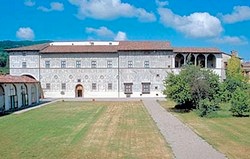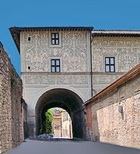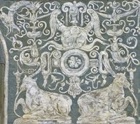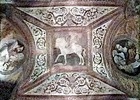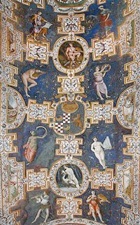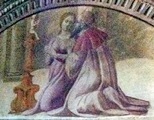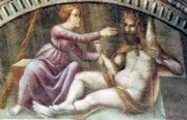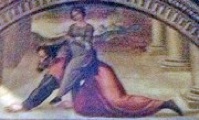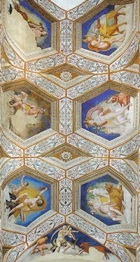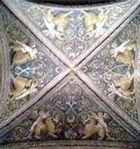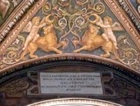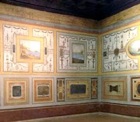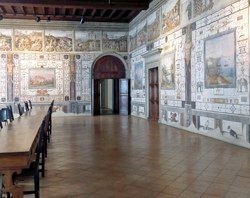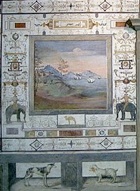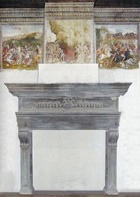This is one of four surviving Vitelli palaces in Città di Castello: the other three are described in the page Other Vitelli Palaces.
Alessandro Vitelli purchased land here in 1521 in order to build a new palace. The work was carried out in four phases:
-
✴The path in the photograph above leads to the original nucleus of the palace. The seven small windows arranged vertically (to the left of the bush in the photograph above) illuminate its inner staircase. An inscription in the lunette of the portal on the landing at the top of the second flight of stairs, which led to the original main reception room (now Room VII - see below) suggests that this phase of construction was complete by the time of Alessandro’s marriage, in 1531, to the redoubtable Angela Paola de' Rossi di San Secondo Parmense.
-
✴A major extension of the palace to the south began in ca. 1534. This part of the palace originally had an open loggia along its ground floor, one column of which can be seen in what is now Room XVIII of the Pinacoteca. Its arches seem to have been closed by 1537. The six tondi that decorated its spandrels originally contained terracotta heads of Roman emperors and members of the Vitelli family, but these were removed and sold in 1832.
-
✴In 1543, the Commune gave permission for the erection of an arch over the adjoining street. This facilitated the completion of the extension of the palace to the south.
-
✴The north wing, including the open loggia on its upper floor, was added in 1545.
The most remarkable thing about this palace seems to have been its garden: a document of 1595 describe it as a “place of delight, worthy of [Alessandro Vitelli]”. The palace was designated as Palazzo del Giardino. The surrounding area a “vocabolo il Giardino Vecchio, ut dicitur della Cannoniera”. From this it seems that this district had been named alternatively for an older garden here or for a cannon factory.
The antiquarian Elia Volpi (died 1938), who came from Città di Castello, bought and restored the palace in 1907. He donated it to the Commune in 1912 to provide a new home for what is now the Pinacoteca Comunale.
Frescoes of the Garden Facade (1534-7)
According to Giorgio Vasari’s “Life” of Cristofano Gherardi, il Doceno, who had enlisted under Alessandro Vitelli in Florence after the fall of that city to imperial forces in 1530, Alessandro Vitelli “determined to send ... [Cristofano] to decorate with sgraffiti and paintings a garden and loggia that he had begun”. However, this plan initially came to nothing.
Alessandro Vitelli subsequently sent Giorgio Vasari himself, together with Antonio da Sangallo il Giovane and Pier Francesco da Viterbo to “repair the walls of the above-mentioned garden..., which were threatening to fall down”. Vasari took Cristofano Gherardi and other pupils with him, and they completed, to Vasari’s designs:
-
✴friezes in “certain apartments” (see below);
-
✴“scenes and compartments” in a bathroom; and
-
✴frescoes for the “walls of the loggia”.
Cristofano Gherardi apparently distinguished himself on this project. As a result according to Vasari, Alessandro Vitelli did not help him to avoid exile from Florence when he was accused of treason in 1537, “to the end that Cristofano might be ... forced to serve him in the work of his garden in Città di Castello”.
It is generally accepted that Vasari provided the initial designs for the monochrome frescoes of the garden facade and that their execution was largely the work of Cristofano Gherardi. He probably began them during his visit to Città di Castello with Vasari in ca. 1534 and completed them in 1537, by which time the ground floor loggia had presumably been closed. The frescoes on the arch over the street to the left must have been executed after 1543, presumably by another artist. These were largely repainted in 1912.
Frescoes of the Staircase
The frescoes of Palazzo Vitelli alla Cannoniera that were executed after 1537 are mostly attributed to Nicola Filotesio, called Cola dell' Amatrice and/or his workshop. (The Emperor Charles V granted Amatrice in feud Aleesandro Vitelli in 1538). This is the case for all of the frescoes on the main staircase, except for those on the second landing (which is attributed to Cristofano Gherardi).
First Landing
The central scene here of a knight on horseback is damaged. The figures in tondi in the lunettes to the sides are:
-
✴Diogenes presenting Plato with a plucked cockerel (on the left in this photograph), because Plato had defined Man as a featherless biped allowing Diogenes to tease him in public with the words: "Here is Plato's man";
-
✴Moses and David (not shown); and
-
✴the Tiburtine and Cumaean sibyls (on the right).
First Flight
The central motifs here depict (from the bottom):
-
✴Clio, the muse of history, sitting on a swan;
-
✴the Vitelli arms, quartered with the rampant lion of the Rossi family; and
-
✴Apollo with a three-headed monster beneath his feet.
The other muses are depicted to the sides, with scenes from the myths of Apollo along the long sides.
The scene at the top in the photograph above depicts of two bulls and a dragon harassing a ram in an oak tree. This is said to be an allegory of the struggle between the Vitelli family and Pope Sixtus IV (whose arms included an oak tree).
Second Landing
As noted above, the frescoes on this landing are attributed to Cristofano Gherardi, il Doceno.
-
✴The four main compartments contain figures of (respectively) a dragon, a sphinx with a lion’s head, a griffin and a cat, each in an oval field surrounded by grotesques.
-
✴Two lunettes to the sides contain heads in tondi of (respectively) the Emperor Augustus and the Emperor Claudius.
Second Flight
This flight of stairs almost certainly had a frescoed vault, but this has been destroyed. The tondi in the friezes along the tops of the walls contain frescoed busts of famous couples from history.
Third Landing
King Solomon and Hercules and Queen Omphale Aristotle and the courtesan, Phyllis
his Edomite wife
The main compartments of the vaults of this landing are decorated with heraldic symbols. The three lunettes contain allegories of the triumph of love:
-
✴King Solomon and the Edomite princess, one of his many wives, who persuaded him to worship the pagan Neptune;
-
✴Hercules with Queen Omphale, who bought him as a slave and subjected him to various indignities after he became infatuated by her; and
-
✴Aristotle and the courtesan, Phyllis, who seduced him and then tricked him into this compromising position in revenge for his opposition to her relationship with King Philip of Macedonia.
Third Flight
The figures in hexagons here represent the signs of the universe.
Fourth Landing
The four compartments of the vault here contain two pairs of cows and two pairs of lions, representing, respectively, the Vitalli and Rossi families.
The inscription in the lunette of the portal that led to the original main reception room (now Room VII) reads:
PAULA PARMENSIS SUO CUM CONJUGE
QUIETI PROPRIAE ET PARENTUM
EREXERUNT
NE NOMINIS ET VIRTUTIS MEMORIA
PEREAT
(Paula of Parma and her husband, for her own tranquility and that of her parents, erected [this inscription?] so that the memory of the name and the virtue will not fade).
Room VIII
Studiolo (Room IX)
This room, which belongs to the second phase of construction, served as the study of Alessandro Vitelli. Its frescoes, which are attributed to
Cola dell' Amatrice, depict scenes from the life of his namesake, Alexander the Great.
Grande Salone (Room XI)
The frescoes (1537)
in the lower and middle registers of the north and east walls of this room, which are dated by inscription, are attributed to
Cristofano Gherardi, il Doceno.
These depict landscape scenes in fictive frames, with interesting representations of dogs and other animals below (as in this scene on the east wall).
The frescoes that were painted at this time on the other original walls of this room were lost when was extended to become the main reception room as part of the second phase of construction. The original monochrome historical scenes in the top register of the north and east walls were over-painted during the subsequent redecoration of the room.
The paintings that now form the frieze in the top register around the whole room
are attributed to Cola dell' Amatrice. Starting from the left of the south wall (which contains the fireplace) and proceeding clockwise, these depict:
-
✴nine scenes from the history of Hannibal (seven on the south wall and two on the west wall);
-
✴nine scenes from the history of Scipio (along the remainder of the west wall);
-
✴twelve scenes from the history of JuliusCaesar (six on the north wall and six on the east wall); and
-
✴twelve scenes from the history of Alexander the Great (in two registers along the rest of the east wall).
In the scene above the fireplace, Hannibal’s soldiers break rocks to carve a path across the Alps, using vinegar and fire. When the room was in use in the winter, the smoke in the scene would have been enhanced by the real smoke from the fire below.
Other Frescoes
Room II Room V Room VI
The friezes of Rooms II, V and VI are attributed to Cristofano Gherardi, il Doceno.
Art from the Palace
Noli me Tangere (1530s ?)
In his life of Jacopo Carucci da Pontormo, Giorgio Vasari wrote: “Signor Alfonso Davalos, Marchese del Vasto, having obtained from Michelangelo Buonarroti ... a cartoon of Christ appearing to the Magdalene in the garden, moved heaven and earth to have it executed for him in painting by Pontormo, Michelangelo having told him that no one could serve him better than that master. Jacopo then executed that work to perfection, and it was accounted a rare painting by reason both of the grandeur of Michelangelo's design and of Jacopo's colouring. Wherefore Signor Alessandro Vitelli, who was at that time Captain of the garrison of soldiers in Florence, having seen it, had a picture painted for himself from the same cartoon by Jacopo, which he sent to Citta di Castello and caused to be placed in his house. This was probably in Palazzo Vitelli alla Cannoniera.


